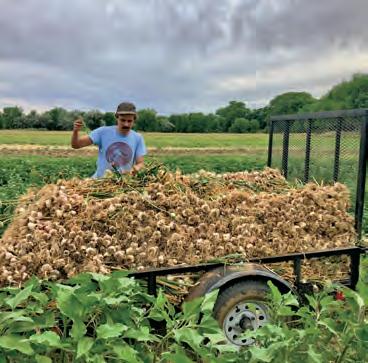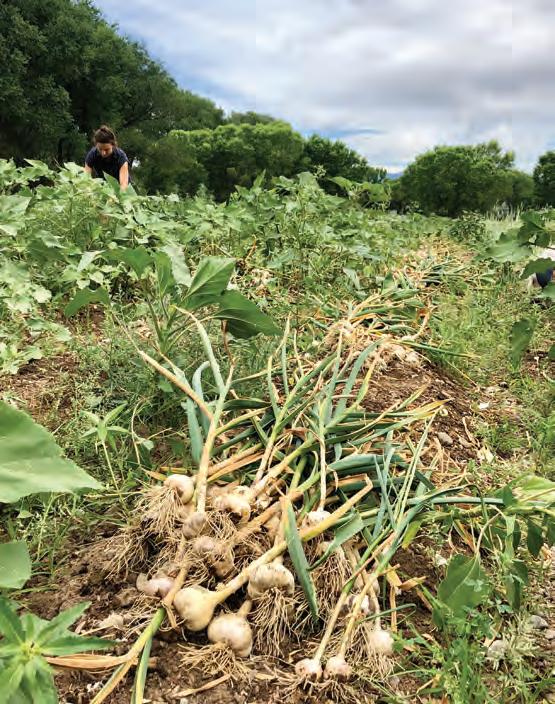
6 minute read
AN EXTRAORDINARY SEASON Thoughts on growing in the pandemic by Carmen Taylor

Garlic harvest at Annie’s Herb Farm.
Advertisement

An Extraordinary Season Thoughts on growing in the pandemic. Story and photos by Carmen Taylor
This spring, when the pandemic shifted my universe into the blurry parallel of a previous life, I was struck by how little the seasons cared. The natural world persisted in its slow turnover from frosty nights to thawing ground, from bare, ghosted tree limbs to succulent leaf buds. In the farming community of northern New Mexico, we had little choice but to keep pace with this turning over, even as societal life ground to a halt. My partner planted potatoes and onions like any other year and we covered future promises of a bodacious summer garden with soil in seed trays. The plants, if nothing else, assured our future, as their seed heads sprouted small, delicate greens. In my privilege to rest closer to the rhythms of early spring, it became clear that this season would be extraordinary, would change not only my personal relationships but also the relationships we have to one another as societal beings. Unlike the constant transition toward summer, however, I couldn’t tell which changes would stick. Early in the pandemic, one of my closest friends, Annie Krahl, started what she called “The Crisis Collective.” In an effort to bring farmers together and create a different way of distributing their crops, Annie organized a CSA designed to cut out middlemen. She gathered producers within thirty miles of Española to contribute a product to the weekly share that she would then deliver to Santa Fe. I was surprised to see a cluster of farmers hanging in the shade. They had dropped off their eggs, arugula, and radishes, but lingered for conversation, one that meandered with no particular thread except, perhaps, the desire to be in proximity to one another, to take a deep sip of company after weeks of quarantine.
One afternoon, when I went to Annie’s farm to help her pack the produce bags, I was surprised to see a cluster of farmers hanging in the shade. They had dropped off their eggs, arugula, and radishes, but lingered for conversation, one that meandered with no particular thread except, perhaps, the desire to be in proximity to one another, to take a deep sip of company after weeks of quarantine. We talked about failed tomato starts, struggling relationships, ice cream cravings, the lines of cars in Sonic’s drive-thru. When Annie and I finally shooed away the last farmer, wanting to catch up alone, I was struck by the amount of time Annie volunteered in order to make the collective work. She wasn’t paying herself anything, ensuring that farmers could charge full price and the CSA bags would remain affordable for customers. I should add here that she was also pregnant, her belly threatening to grow big enough to keep her from bending over to harvest her greens. When I asked Annie, Why did you start this? she offered answers about being of service, of getting food to the people, of stepping up in hard times. I knew that her intentions were genuine, but I also couldn’t help but wonder where else her superhuman energy came from, her seemingly tireless dedication on days when I felt that I could barely keep myself together. So I also asked her, How do you think being pregnant has shaped the decisions you’re making? As she answered, it occurred to me that while I had the space to fall apart, Annie didn’t have a choice. “I want my baby to grow up in a beautiful, cooperative world,” Annie admitted, almost pleading with me to agree that this was a realistic request. Her hard work wasn’t just for the farmers, it was for the future, a visceral future for her, one she carried around as she bunched 14
carrots, wrote out receipts, checked in with another farmer about his living situation, hustled boxes of vegetables to town in her pickup, rested her hand on her stomach. And that’s just it, no one necessarily wants to be resilient; it’s a condition that often arises when there is no other option but to persist. As the lock-down in New Mexico eased in mid-May, Annie’s CSA subscriptions diminished, she entered her third trimester, and she decided to stop the program. At first, the farmers’ collective had seemed like a simple, mutually beneficial way for Annie to serve her customers and support fellow farmers, many of whom were excited and eager to join her. Yet, as concerns over the crisis began to wane, Annie felt that the individual interests of the farmers started to undermine the cooperative spirit of the CSA. Some participants preferred to return to their individual endeavors, now that those options had opened — starting their own CSAs or selling more of their product at the Santa Fe Farmers’ Market. At its height, 12 or 13 farmers were participating; by the time Annie stopped the service, that number had dwindled to three or four. What so recently felt like a window into a more cooperative future among farmers had turned into a conversation about the barriers to operating as a better-united force of small producers. “I was disappointed in some community members and farmers. I didn’t do things perfectly either, but when the crisis had faded, that resilient, community-oriented action disappeared,” Annie reflected to me over a recent phone call. We both mused about what changes would remain beyond the pandemic, both of us a little tired, a little skeptical. I write this in July. Summer is churning on — the potato plants knee-high, the onion field sacrificed to weeds, and garlic harvest in full swing. New Mexico has halted its next phase of reopening amidst concerns over growing cases of COVID-19. This week’s temperatures will climb up toward 100 degrees and the summer monsoons have yet to arrive. It seems we must now face a second wave of the pandemic in addition to drought. As the rainless days persist, a dry anxiety has been accompanying me to bed. Yet, in talking with my partner, the vegetable farmer Brett Ellison, I’ve also found some hope and wisdom, characteristically encased in a good seed metaphor. “Community involvement can be similar to the growth of a herd, or the growth of a seed stock,” he said. “Once the community decides that they want to have some type of food sovereignty, they’re going to put their energy and economics toward that in order to make it successful. It’s going to blossom; it’s going to multiply.” Will it take another wave of the virus, coupled with drought, to see more community engagement and long-term change in support of more resilient food systems? There’s seemingly no answer to how our society, how our food tending and distributing, will change, only that it must. Remembering winter on these hazy summer days reminds me, again, how the seasons are always in transition. If only we could follow suit. For now, I’m buoyed by the view outside my window as the leaves of the sweet corn grow fuller each moon cycle, by the knowledge of the many generations who came before me, and of the original inhabitants of this land, who coaxed gardens out of this desert and survived. Annie harvesting radishes.











